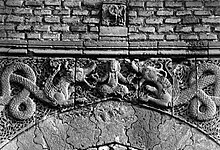
Back أحمد الناصر لدين الله Arabic احمد الناصر لدين الله ARZ Ən-Nasir AZ ناصر (خلیفه) AZB An-Nàssir (abbàssida) Catalan An-Nāsir li-Dīn Allāh German Αλ-Νασίρ Greek An-Nasir EO An-Násir Spanish ناصر (خلیفه) FA
| al-Nāṣir li-Dīn Allāh الناصر لدين الله | |
|---|---|
| Khalīfah Amir al-Mu'minin | |
 Possible depiction of Al-Nasir holding two dragons, which could be a symbol of his victory of his two major enemies: the Grand Master of the Assassins, and the Khwarizmian Empire ruler Muhammad II. Baghdad, Bab al-Talsim, built circa 1221-22.[1] | |
| 34th Caliph of the Abbasid Caliphate Abbasid Caliph in Baghdad | |
| Reign | 28 March 1180 – 5 October 1225 |
| Predecessor | al-Mustadi |
| Successor | al-Zahir |
| Born | 6 August 1158 Baghdad, Abbasid Caliphate |
| Died | 5 October 1225 (aged 67) Baghdad, Abbasid Caliphate |
| Consort |
|
| Issue | |
| Dynasty | Abbasid |
| Father | al-Mustadi |
| Mother | Zumurrud |
| Religion | Sunni Islam |
Abū al-ʿAbbās Aḥmad ibn al-Hasan al-Mustaḍīʾ (Arabic: أبو العباس أحمد بن الحسن المستضيء), better known by his laqab al-Nāṣir li-Dīn Allāh (الناصر لدين الله; 6 August 1158 – 5 October 1225) or simply as al-Nasir, was the Abbasid caliph in Baghdad from 1180 until his death. His laqab literally can mean The One who Gives Victory to the Religion of God. He continued the efforts of his grandfather al-Muqtafi in restoring the caliphate to its ancient dominant role and achieved a surprising amount of success as his army even conquered parts of Iran.[3] According to the historian, Angelika Hartmann, al-Nasir was the last effective Abbasid caliph.[4]
In addition to his military success al-Nasir built many monuments in Baghdad that are still standing such as Zumurrud Khatun Mosque and Mausoleum.
- ^
- Hillenbrand, Robert (1999). Islamic art and architecture. London : Thames and Hudson. p. 124, Fig. 97. ISBN 978-0-500-20305-7.
- El-Hibri, Tayeb (22 April 2021). The Abbasid Caliphate: A History. Cambridge University Press. p. 237. doi:10.1017/9781316869567.005.
It has been suggested that an image al-Nasir had carved over Bab al-Talsim, the Talisman Gate of Baghdad, in 618/1221, showing a seated figure holding two dragons at bay with his outstretched hands, was meant as symbolic of the caliph's success in subordinating the Ismaʿili Grand Master and the Khwarazm shah. The image remained there up until World War I, when the gate was blown up by the retreating Ottoman troops in 1917.
- Kuehn, Sara (2011). The dragon in medieval East Christian and Islamic art. Leiden: Brill. pp. 25–26. ISBN 978-90-04-18663-7.
One of the most outstanding examples of the dragon iconography on city gates certainly must have been the monumental sculptures on the archivolt of the so-called Talisman Gate (Bāb al-Talism) in Baghdad which was destroyed in 1917 during the First World War. (...) It showed a seated figure that presumably represented the caliph in the act of subduing a pair of mighty confronted dragons whose expansive serpentine bodies entirely filled the rest of the archivolt.
- ^ Hassan, M. (2018). Longing for the Lost Caliphate: A Transregional History. Princeton University Press. p. 284 n. 13. ISBN 978-0-691-18337-4.
- ^ El-Hibri, Tayeb (2021-04-22). The Abbasid Caliphate: A History. Cambridge University Press. ISBN 978-1-107-18324-7.
- ^ Hanne, Eric J. (2007). Putting the Caliph in His Place: Power, Authority, and the Late Abbasid Caliphate. Fairleigh Dickinson University Press. p. 204. ISBN 978-0-8386-4113-2.